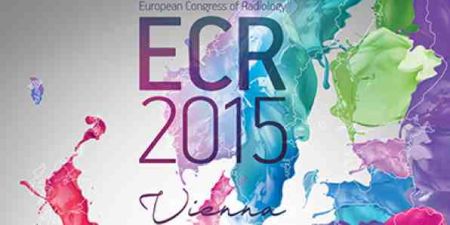New methods that make it possible to visualise activity on a molecular level will boost optical imaging use in radiology, especially oncology applications. Experts will unveil the secrets of Cerenkov (blue light) radiation, reporter gene imaging and opto-acoustics techniques today during a New Horizons session at the ECR.
Speakers will look at molecular activity at the level of gene expression, tumour progression and metastasis, using reporter genes as well as a completely new imaging approach using the blue light of Cerenkov radiation as a tool to optically image radiotracers.
Cerenkov radiation is based on Cerenkov light, which is induced by particle-emitting isotopes. The detection of Cerenkov light by highly sensitive optical cameras is known as Cerenkov Luminescence Imaging. Cerenkov radiation offers a unique opportunity to make use of clinically approved radiotracers for optical imaging, according to physician-scientist Prof. Jan Grimm, who works at Memorial Sloan-Kettering Cancer Center in New York developing innovative imaging approaches, including Cerenkov radiation, for diagnosing cancer.
“In PET imaging, we can use PET tracers for pre-surgical imaging and during surgery to localise tumour deposits, and then repeat the PET scan after surgery, if needed, all with one and the same agent,” he explained. “However, there is a big push for dual modality (fluorescent and radioactive) agents these days, which combine a fluorochrome [a fluorescent chemical compound that can re-emit light upon light excitation] and a tracer in one molecule. We believe this is unnecessary; the tracer with Cerenkov emission is enough.”
Very few fluorochromes are clinically approved, and novel targeted agents would require regulatory approval that would take considerable time and have no guarantee of success. On the other hand, many targeted tracers are already available and can be used for optical Cerenkov imaging, he said.
Cerenkov radiation also provides unique features that allow for quantitative optical imaging, which is not always possible with other methods.
Prof. Clemens Löwik from Leiden University Medical Centre, the Netherlands, will present an overview of reporter gene imaging, where the promoter (or on/off) switch of a gene is fused to a reporter gene that can be imaged.
Reporter gene imaging in cells and preclinical animal models offers the opportunity to study all kinds of cellular and molecular processes, including the regulation of gene expression, drug effects, and tracking of transplanted cells carrying optical gene reporters, Löwik explained.
He will show how reporter gene imaging can follow tumour progression, T-cell migration towards the tumour, activation of T-cells after vaccination with a tumour antigen, and eradication of the tumour by T-cells using multi-colour luciferases.
Last but not least, Prof. Dr. Vasilis Ntziachristos, from the Institute for Biological and Medical Imaging at the Helmholtz Centre in Munich, will describe current progress with methods and applications for in-vivo optical and opto-acoustic imaging in cancer.
The continued evolution of PET promises to transform oncology imaging.
New Horizons Session
Saturday, March 7, 14:00–15:30, Room E2
NH 15 Optical molecular imaging: a new dimension for radiology
Chairman’s introduction - C.-C. Gluer; Kiel/DE
Reporter gene imaging - C.W.G.M. Lowik; Leiden/NL
Cerenkov – faster than the speed of light - J. Grimm; New York, NY/US
The kiss of light and sound – optoacoustics - V. Ntziachristos; Munich/DE
Panel discussion: Potential of optical imaging for translation to human applications
Speakers will look at molecular activity at the level of gene expression, tumour progression and metastasis, using reporter genes as well as a completely new imaging approach using the blue light of Cerenkov radiation as a tool to optically image radiotracers.
Cerenkov radiation is based on Cerenkov light, which is induced by particle-emitting isotopes. The detection of Cerenkov light by highly sensitive optical cameras is known as Cerenkov Luminescence Imaging. Cerenkov radiation offers a unique opportunity to make use of clinically approved radiotracers for optical imaging, according to physician-scientist Prof. Jan Grimm, who works at Memorial Sloan-Kettering Cancer Center in New York developing innovative imaging approaches, including Cerenkov radiation, for diagnosing cancer.
“In PET imaging, we can use PET tracers for pre-surgical imaging and during surgery to localise tumour deposits, and then repeat the PET scan after surgery, if needed, all with one and the same agent,” he explained. “However, there is a big push for dual modality (fluorescent and radioactive) agents these days, which combine a fluorochrome [a fluorescent chemical compound that can re-emit light upon light excitation] and a tracer in one molecule. We believe this is unnecessary; the tracer with Cerenkov emission is enough.”
Very few fluorochromes are clinically approved, and novel targeted agents would require regulatory approval that would take considerable time and have no guarantee of success. On the other hand, many targeted tracers are already available and can be used for optical Cerenkov imaging, he said.
Cerenkov radiation also provides unique features that allow for quantitative optical imaging, which is not always possible with other methods.
Prof. Clemens Löwik from Leiden University Medical Centre, the Netherlands, will present an overview of reporter gene imaging, where the promoter (or on/off) switch of a gene is fused to a reporter gene that can be imaged.
Reporter gene imaging in cells and preclinical animal models offers the opportunity to study all kinds of cellular and molecular processes, including the regulation of gene expression, drug effects, and tracking of transplanted cells carrying optical gene reporters, Löwik explained.
He will show how reporter gene imaging can follow tumour progression, T-cell migration towards the tumour, activation of T-cells after vaccination with a tumour antigen, and eradication of the tumour by T-cells using multi-colour luciferases.
Last but not least, Prof. Dr. Vasilis Ntziachristos, from the Institute for Biological and Medical Imaging at the Helmholtz Centre in Munich, will describe current progress with methods and applications for in-vivo optical and opto-acoustic imaging in cancer.
The continued evolution of PET promises to transform oncology imaging.
New Horizons Session
Saturday, March 7, 14:00–15:30, Room E2
NH 15 Optical molecular imaging: a new dimension for radiology
Chairman’s introduction - C.-C. Gluer; Kiel/DE
Reporter gene imaging - C.W.G.M. Lowik; Leiden/NL
Cerenkov – faster than the speed of light - J. Grimm; New York, NY/US
The kiss of light and sound – optoacoustics - V. Ntziachristos; Munich/DE
Panel discussion: Potential of optical imaging for translation to human applications
Latest Articles
ECR 2015, molecular imaging, #ECR15
New methods that make it possible to visualise activity on a molecular level will boost optical imaging use in radiology, especially oncology applications....



























